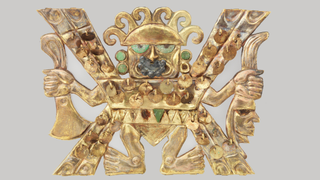Astonishing artifacts: A glimpse into how people lived in the past
Artifacts offer a window into the past, giving us information about people and cultures that existed centuries to millennia ago. From hoards of gold coins found hidden beneath floorboards to handmade pottery buried in caves, these intriguing objects are often the only physical evidence that remains. In some cases, the purpose or meaning of an artifact is lost to time, but its presence still reveals hints of what cultures valued or ritualized.
Each week, we showcase a different astonishing artifact that gives us new insight into how our ancestors lived.
Explore more amazing artifacts
—30 incredible treasures discovered in King Tut's tomb
—32 haunting shipwrecks from the ancient world
—32 stunning centuries-old hoards unearthed by metal detectorists
Latest about astonishing artifacts

Magdala stone: 2,000-year-old carving from Jerusalem is world's oldest known depiction of a menorah
By Kristina Killgrove published
A pilgrim who visited the Second Temple in Jerusalem may have carved their memories into a limestone block for another synagogue.

Ash Pendant: The only known depiction of a pregnant Viking woman
By Kristina Killgrove published
The Ash Pendant was discovered in a Viking Age burial mound in Sweden and may have been used by a female shaman.

Roman sun hat: A 'very rare' 1,600-year-old brimmed cap that may have protected a Roman soldier from Egyptian sandstorms
By Kristina Killgrove published
A rare example of a sun hat from late Roman Egypt that was stitched together from fabrics in five colors.

Pectoral with coins: 'One of the most intricate pieces of gold jewelry to survive from the mid-sixth century'
By Kristina Killgrove published
This sixth-century pectoral comprises 14 Byzantine gold coins and a gold disc gathered over two centuries.

Caergwrle Bowl: A 3,300-year-old stone-and-tin bowl with gold oars and 'protective eyes'
By Kristina Killgrove published
The ancient stone-and-tin bowl was discovered 200 years ago in a boggy field in Wales.

Merit's wig: A 3,400-year-old Egyptian headpiece smoothed down with ancient homemade hair gel
By Kristina Killgrove published
Merit's head covering was made from real human hair and was buried with her in its own wooden cabinet.

Memento Mori: A mosaic that predates Mount Vesuvius' eruption in Pompeii and reminds us that we will all die
By Kristina Killgrove published
A famous mosaic from Pompeii holds lessons for today.

Decapitator nose ornament: 1,500-year-old gold jewelry depicting a bloodthirsty South American god
By Kristina Killgrove published
The Moche made human sacrifices to their gods, including Ai Apaec, the Decapitator.
Get the world’s most fascinating discoveries delivered straight to your inbox.




